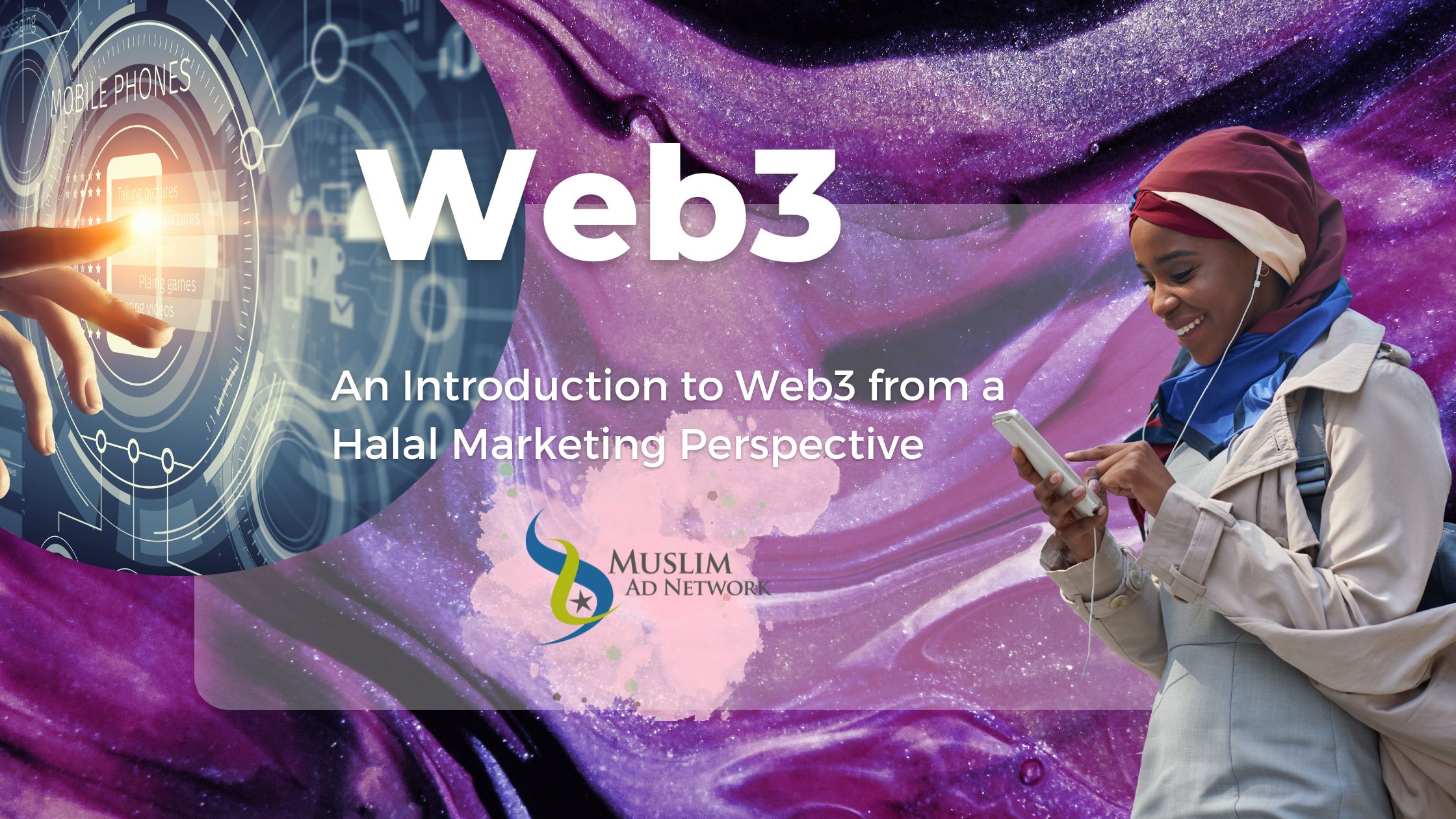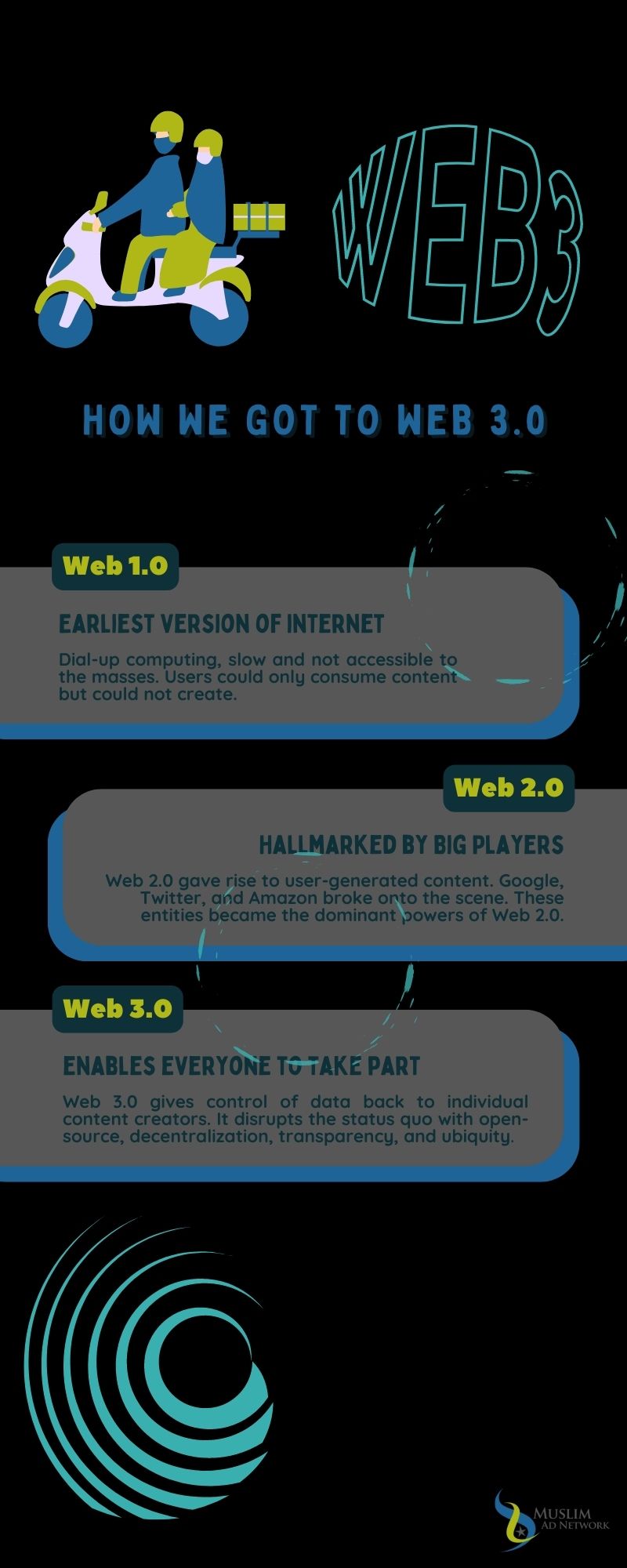
- An Introduction to Web3 from a Halal Marketing Perspective
- How to Leverage Web3 to Target Muslim Consumers
As a result of Web3 or as it’s also known, Web 3.0, marketing professionals may be able to take advantage of many innovative advancements in the decentralized web. We do need to keep in mind that Web3 is still in its infant stages despite becoming the biggest talking point in digital marketing today.
The halal marketing strategies and Muslim advertising tactics that will be in demand as Web 3.0 matures remain to be seen. However, to have an idea of where it is all heading, it is important to know today’s trends that power marketing in the Web3 landscape and the challenges that come with them. We aim to help you understand this in this two-part article about Web 3.0 from a halal marketing perspective.
Defining Web3 to Halal Marketers
What is Web3?
The first era of the internet began in the 1990s giving people access to an abundance of data. However, there was no simple way to sift through all of this information.
The second iteration started in the 2000s with Google, Twitter, and Amazon breaking onto the scene. In the time frame of almost two decades, these entities became the dominant powers of Web 2.0.
Web 3.0 is based on decentralization and gives control of data back to individual content creators. This will hopefully level the playing field for startups, and small businesses. It may also be the end of consumer data privacy infringement for the most part.
Computer Scientist and Ethereum Co-Creator, Gavin Wood, who coined the term “Web 3.0” explains:
“Essentially, under Web3, we know exactly what’s happening with our data.”
Like many advocates of Web 3.0, Josh Neuroth, Head of Product at Ankr, a Web3 infrastructure company agrees:
“The whole point of Web3 is getting ownership and decision-making away from a small group of people, into the hands of the community. It’s very democratic.”
How We Got to Web 3.0
The first web server emerged in 1990 leading to the creation of the World Wide Web. At first, the internet was only accessible to government and military researchers and college students.
Web 1.0 is a term used to describe the earliest versions of websites. Back then, users were consuming content, not generating it. Due to dial-up computing, websites could take minutes to load, so pages had to be small and lightweight. Web 1.0 was before smartphones and was only accessible by desktop computers.
The Web 2.0 era took off in the early 2000s. With it came interactivity. A dynamic page was now generated for the user instead of a static one. The pages became larger and more complex as broadband expanded its reach. Users could now enjoy streaming music and video.
Web 2.0 gave rise to user-generated content. Prior to the rise of Myspace, Facebook, Twitter, and Instagram, there were precursors to social media, such as GeoCities. Through blogs, tweets, and social media networks, Web 2.0 has allowed for an increase in user input and engagement.
Web 3.0 is the result of various problems in the Web 2.0 ecosystem, especially in terms of data control and safeguards for user privacy. The centralized storage of user data has created extremely vulnerable spots for malicious agents.
Web 3.0 will remain fully decentralized, putting content creation in the hands of the creators and not platform owners. It also means scenarios, where you are not able to target certain profiles online due to changes in platform policies, will not be a common thing. If your brand targets Muslim customers on Facebook, you know how difficult that has become due to their policy changes.
Read: How to Target Muslim Audiences on Facebook – A Quick Solution

Web3 aims to move away from an internet controlled by a handful of powerful people and companies. Open-source, decentralization, transparency, and ubiquity will disrupt the current centralized internet environment.
A trusted environment enables everyone to take part in Web 3.0 without the need for an intermediary or third party.
Components of Web 3.0
Web 3.0 consists of the following six notable components:
Semantic Web: Through the semantic web, data can be linked from one source to another and understood by computers, enabling them to perform increasingly sophisticated tasks for us. Through AI, it is able to understand what a customer or user may mean or intend, thus improving the experience.
Artificial Intelligence: Sometimes the user’s search intent is not matched by the results delivered by the search engine. The AI of Web3 has a better understanding of what users are searching for and gives more relevant and accurate answers.
Ubiquitous Connectivity: Ubiquitous connectivity describes the ability of devices to create, share, and process data without ever losing connection. With broadband, 5G, and IoT, Web 3.0 applications are characterized by ubiquitous connectivity, allowing access to information across a variety of devices.
3D Graphics and Spatial Web: Advances in technology, including virtual reality, today mean that 3D graphics allow the creation of a more realistic online experience. Brands are already incorporating 3D graphics in the promotion of their products and services. A good example of this is the use of special events and gaming.
Blockchain and Cryptocurrency: The Web 3.0 era is intrinsically characterized by blockchain and bitcoin technology. Web 3.0 is characterized by decentralization and giving content creators more power. Direct transactions between parties are made possible by the elimination of middlemen and the use of cryptocurrencies. While bitcoin gets rid of middlemen like financial institutions, blockchain helps make Web 3.0 more transparent and safe.
Metaverse: The phrase “metaverse” truly doesn’t relate to any one particular kind of technology, but rather to a broad and frequently hypothetical change in how humans interact with technology. Generally speaking, it is a simulated digital environment that combines elements of social media, blockchain, augmented reality (AR), and virtual reality (VR) to produce environments for rich user interaction that mirror the real world.
Read: Halal Advertising in the Metaverse and Is the Metaverse the New Online Frontier for Halal Brands?
What is Web3 Marketing?
Your mission, as a halal brand or mainstream brand targeting Muslims, is to grab their attention and convince them to spend their time and money on your product and service.
In Web2, your brand or organization invests in sales and marketing, and the vast majority of the value generated accrues only to the platform being used. Web3 however, shares value ownership and allows users to share the value along with the company through digital tokens.
By using tokens to bring in early users and reward them for their contributions, Web3 creates new networks instead of using the Web2 customer acquisition funnel, where awareness and lead generation are at the top and conversion and customer retention are at the bottom.
In Web3 marketing, there is more to it than just websites and search engine optimization (SEO). Web3 enhances the user experience by providing interactive advertising opportunities. As a marketer, Web3 offers an enormous opportunity to have an extremely efficient Web3 marketing strategy and deliver more targeted ads to Muslim consumers. We will take a look at this in the second part of this series.
Meanwhile, feel free to contact Muslim Ad Network for any questions about advertising to the Muslim audience.
